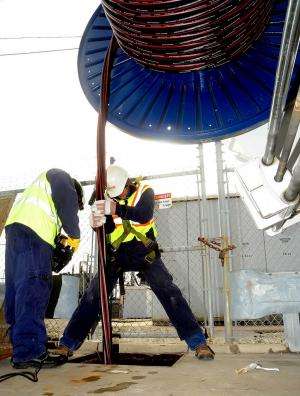July 17, 2014 report
Chicago planning to lay superconducting cable to prevent power outages in the Loop

Huge electricity provider Commonwealth Edison (ComEd) has announced that it plans to lay superconducting cables alongside existing copper cables in parts of downtown Chicago to prevent outages in and around the Loop. The effort is receiving partial financial support from the Department of Homeland Security (DHS).
Superconducting cables are those that are able to carry more electricity than standard power cables—in this case, ten times as much. The plan is to lay such cables next to existing copper cables that exist between substations and customers—thus new trenches or underground work won't be needed. Superconducting cables, the thinking goes would allow for sending more power from substations that aren't impacted during an outage, taking over for those that are—the result would be a portion of the city protected against major power outages. The cables are to be supplied by American Superconductor, which has announced that the company is also in talks with other large metro area suppliers to provide cable for them as well.
The plan to provide better protection against power outages has been long in the making, instances in the past have shown how vulnerable large cities are to such outages—hurricane Sandy being the most recent. DHS has been working with city administrators and power company executives to preempt such outages which can cost businesses millions of dollars in lost revenue. There is also the safety factor—large cities without power are dark and dangerous places. It's not just adverse weather that has DHS worried either, a terrorist attack could possibly cause the same problems.
Companies such as American Superconductor create so-named superconducting cables by using special metal alloys for the wire inside—in this case it's an alloy the company calls Amperium—a brass laminated wire. It allows for conducting up to 200 times more electricity than copper wire. They cover the wire with special materials to help prevent loss of power during transmission. Such cables cost a lot more than copper wire cables of course, which is why they aren't used in all underground applications. DHS has pledged $60 million for the Chicago project, though city planners expect the overall cost to be much higher than that.
More information: Press release: www.comed.com/newsroom/Pages/N … eleases_07162014.pdf
via Chicago Tribune
© 2014 Tech Xplore





















